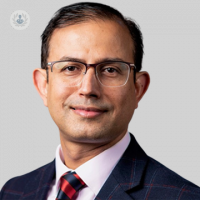Role of knee braces for knee injuries and post-surgery
Written by:In his latest online article, renowned consultant orthopaedic surgeon Mr Muhammad Adeel Akhtar explains the role of knee braces both post-surgery and for knee injuries. He answers patients’ most common questions regarding knee braces, including the benefits and downsides of knee braces, and how patients can choose the correct type of brace.

Are there specific types of injuries or conditions where braces are most effective, or are they more for general support?
Knee braces should not be used for general support, as they may inadvertently weaken thigh muscles, leading to increased pain, weakness, and susceptibility to injuries. However, they do play a crucial role in certain scenarios.
For instance, after acute knee injuries, knee braces offer short-term stability and assist in resting the knee, thereby aiding in functional improvement. Moreover, they provide symptomatic relief for arthritis patients and support recovery after undergoing soft tissue knee surgery.
Beyond stability, do knee braces offer any additional benefits, like pain reduction or faster healing?
Indeed, knee braces can offer additional benefits beyond stability. Off-loading knee braces, for example, helps alleviate pain in arthritis patients by redistributing the load away from the affected areas. However, despite these advantages, there is a lack of substantial evidence supporting the notion that knee braces expedite the actual healing process.
Are there any downsides or risks associated with wearing knee braces?
While knee braces can be beneficial in the short term, prolonged and constant use may have drawbacks. Long-term use of knee braces can potentially lead to stiffness and muscle wasting, which, in turn, may exacerbate knee symptoms over time.
How does a person choose the right knee brace for their specific needs?
Selecting the appropriate knee brace depends on the nature of the injury or condition. For acute knee injuries, a simple extension-type knee brace is suitable for maintaining the knee in a straight position. There are various names for this type of knee brace: Thackary splint, cricket splint, extension splint etc.
Conversely, for rehabilitation purposes, a hinged knee brace offers better control over knee movement degrees while providing stability. This type of brace is commonly used post-ACL reconstruction, patella stabilisation surgery, and high tibial osteotomy in younger osteoarthritis patients.
It's essential to note that over-the-counter knee braces primarily offer warmth without significant therapeutic benefits and should not be relied upon for substantial relief.
What are the latest advancements in knee brace technology?
Recent advancements in knee brace technology include innovative designs such as off-loading knee braces, which effectively manage symptoms of osteoarthritis by redistributing pressure away from the affected areas.
Furthermore, the emergence of smart knee braces equipped with sensors represents a promising development. These braces can measure muscle strength and range of motion, providing valuable data to guide patients' rehabilitation post-knee surgery or injury. Such technological advancements hold great potential in optimising treatment outcomes and enhancing patient rehabilitation.
Mr Muhammad Adeel Akhtar is an esteemed consultant orthopaedic surgeon based in Edinburgh & Sterling. If you would like to book a consultation with Mr Muhammad Adeel Akhtar, you can do so today via his Top Doctors profile.


